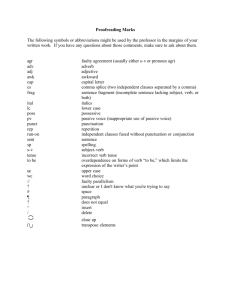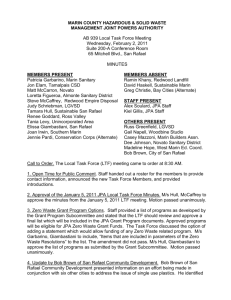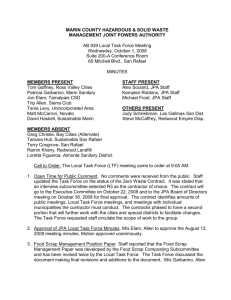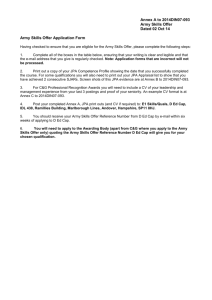YES
advertisement
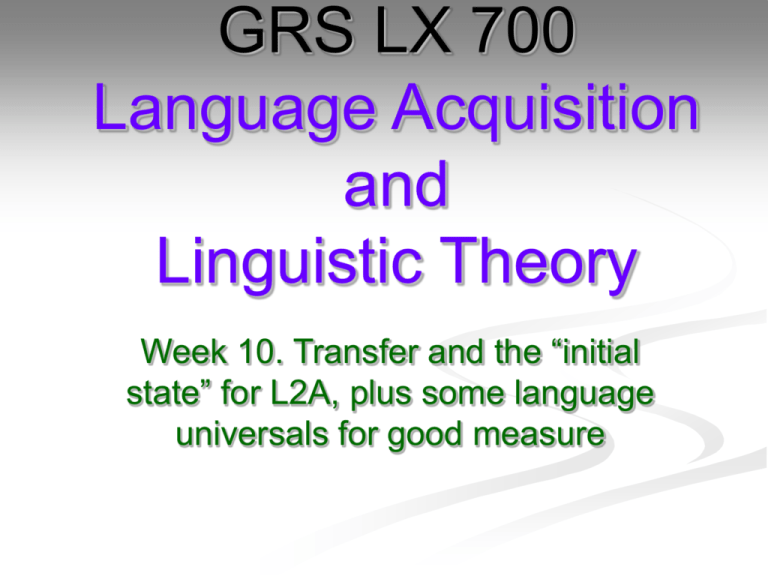
GRS LX 700
Language Acquisition
and
Linguistic Theory
Week 10. Transfer and the “initial
state” for L2A, plus some language
universals for good measure
“UG in L2A” so far
UG principles
UG parameters of variation
(Subjacency, Binding Theory)
(Subjacency bounding nodes, Binding domains, null
subject, VT)
Justified in large part on the basis of L1.
the complexity of language
the paucity of useful data
the uniform success and speed of L1’ers acquiring
language.
“UG in L2A” so far
To what extent is UG still involved in L2A?
Speaker’s “interlanguage” shows a lot of systematicity,
complexity which also seems to be more than the
linguistic input could motivate.
The question then: Is this systematicity “left over”
(transferred) from the existing L1, where we know the
systematicity exists already? Or is L2A also building up a
new system like L1A?
We’ve seen that universal principles which operated in
L1 seem to still operate in L2 (e.g., ECP and Japanese
case markers).
Initial state: 3 options
The L1 (parameter settings)
Parts of the L1 (certain parameter settings)
Schwartz & Sprouse (1996) “Full Transfer/Full
Access”
Eubank (1993/4) “Valueless Features Hypothesis”
Vainikka & Young-Scholten (1994) “Minimal trees”
Clean slate (UG defaults)
Epstein et. al (1996)
Platzack (1996) “Initial Hypothesis of Syntax”
Vainikka & Young-Scholten
V&YS propose that phrase structure is built up from
just a VP all the way up to a full clause.
Similar to Radford’s L1 proposal except that there is
an order of acquisition even past the VP (i.e., IP
before CP). Also similar to Rizzi’s L1 “truncation”
proposal. And of course, basically the same as
Vainikka’s L1 tree building proposal.
V&YS propose that both L1A and L2A involve this
sort of “tree building.”
CP
C
Vainikka (1993/4), L1A
AgrP
C
that
DP
she
Agr
Agr
TP
T
T
will
VP
V
V
An adult clause,
where kids end up.
The subject pronoun
is in nominative case
(I, he, they), a case
form reserved for
SpecAgrP in finite
clauses (cf. me, him,
them or my, his, …).
DP
eat
lunch
CP
C
Vainikka (1993/4), L1A
AgrP
C
that
Agr
DP
she
Agr
TP
T
T
will
Very early on, kids are
observed to use nonnominative subjects almost
all the time (90%) like:
My make a house
VP
The fact that the subject is
non-nominative can be
taken as an indication that
it isn’t in SpecAgrP.
V
V
Nina (2;0)
DP
eat
lunch
Vainikka (1993/4), L1A
VP
DP
V
V
my make
DP
a house
Vainikka’s proposal
was that children
who do this are in a
VP stage, where
their entire syntactic
representation of a
sentence consists
of a verb phrase.
Vainikka (1993/4), L1A
AgrP
Agr
DP
I
Agr
TP
T
T
As children get older,
they start using
nominative subjects
I color me
VP
V
V
DP
color
me
Nina (2;1)
But interestingly, they
do not use nominative
subjects in whquestions
Know what my
making?
Nina (2;4)
Vainikka (1993/4), L1A
AgrP
Agr
DP
I
Agr
I color me
TP
T
T
VP
The nominative subject
tells us that the kid has at
least AgrP in their
structure.
Know what my making?
V
V
DP
color
me
Nina (2;1)
Nina (2;4)
Normally wh-movement
implies a CP (wh-words
are supposed to move
into SpecCP).
Vainikka (1993/4), L1A
AgrP
Agr
DPi
what
Know what my
making?
Agr
TP
T
T
VP
DP
my
V
V
making
ti
Nina (2;4)
However, if there is no
CP, Vainikka
hypothesizes that the
wh-word goes to the
highest specifier it can
go to—SpecAgrP.
Which means that the
subject can’t be there,
and hence can’t be
nominative.
CP
C
Vainikka (1993/4), L1A
AgrP
C
that
Agr
DP
she
Agr
TP
T
T
will
VP
V
V
DP
eat
lunch
Finally, kids reach a
stage where the
whole tree is there
and they use all
nominative subjects,
even in wh-questions.
Vainikka (1993/4)
So, to summarize the L1A proposal: Acquisition goes in
(syntactically identifiable stages). Those stages
correspond to ever-greater articulation of the tree.
VP stage:
AgrP stage:
No nominative subjects, no wh-questions.
Nominative subjects except in wh-questions.
CP stage:
Nominative subjects and wh-questions.
Vainikka & Young-Scholten’s
primary claims about L2A
Vainikka & Young-Scholten take this idea and
propose that it also characterizes L2A… That
is…
L2A takes place in stages, grammars which
successively replace each other (perhaps after
a period of competition).
The stages correspond to the “height” of the
clausal structure.
Vainikka & Young-Scholten
V&YS claim that L2 phrase structure
initially has no functional projections, and
so as a consequence the only information
that can be transferred from L1 at the
initial state is that information associated
with lexical categories (specifically,
headedness). No parameters tied to
functional projections (e.g., V->T) are
transferred.
V&YS—headedness transfer
Cross-sectional: 6 Korean, 6 Spanish, 11
Turkish. Longitudinal: 1 Spanish, 4 Italian.
In the VP stage, speakers seem to produce
sentences in which the headedness matches
their L1 and not German.
L1
Korean/Turkish
L1 head
final
% head-final VPs in L2
98
Italian/Spanish (I)
Italian/Spanish (II)
initial
initial
19
64
V&YS—headedness transfer
VP-i: L1 value transferred for head-parameter, trees truncated at VP.
VP-ii: L2 value adopted for head-parameter, trees still truncated at VP
Bongiovanni
Salvatore
NL
I
I
VPs
20
44
V-initial
13 (65%)
35 (80%)
V-final
7
9
Jose
Rosalinda
Antonio
S
S
S
20
24
68
15 (75%)
24 (100%)
20
5
0
48 (71%)
Jose
Lina
Salvatore
S
I
I
37
24
25
23
7
6
14 (38%)
17 (71%)
19 (76%)
CP
Predictions
C
AgrP
C
Agr
DP
Agr
TP
T
T
VP
V
V
DP
Different parts of the
tree have different
properties associated
with them, and we
want to think about
what we would predict
we’d see (if Vainikka
& Young-Scholten are
right) at the various
stages.
CP
Predictions
C
AgrP
C
Agr
DP
Agr
T/Agr (=INFL):
TP
T
T
VP
V
V
Modals and auxiliaries
appear there
Verbs, when they
raise, raise to there.
Subject agreement is
controlled there
C
DP
Complementizers
(that, if) appear there
Wh-questions involve
movement to CP
CP
Predictions
C
AgrP
C
Agr
DP
Agr
TP
T
T
So, if there is just a
VP, we expect to find:
VP
V
V
DP
No evidence of verb
raising.
No consistent
agreement with the
subject.
No modals or
auxiliaries.
No complementizers.
No complex sentences
(embedded
sentences)
V&YS L2A—VP stage
stage
At the VP stage, we
find lack of
VP
VP
verb raising (INFL
and/or CP)
VP-i
auxiliaries and modals
VP-ii
(generated in INFL)
an agreement
VP-i
paradigm (INFL)
VP-ii
complementizers (CP)
wh-movement (CP)
L1
Aux
Mod
Default
Kor
Tur
It
It
1
0
0
0
1
1
0
0
68
75
65
82
Sp
Sp
8
1
5
1
74
57
All came from Rosalinda (Sp.); three
instances of wolle ‘want’ and five with is(t)
‘is’—evidence seems to be that she doesn’t
control IP yet.
V&YS L2A—VP stage
At the VP stage, we find lack of
verb raising (INFL and/or CP)
auxiliaries and modals (generated in INFL)
an agreement paradigm (INFL)
complementizers (CP)
wh-movement (CP)
Antonio (Sp): 7 of 9 sentences with temporal
adverbs show adverb–verb order (no raising); 9
of 10 with negation showed neg–verb order.
Turkish/Korean (visible) verb-raising only 14%.
V&YS L2A—VP stage
At the VP stage, we find lack of
verb raising (INFL and/or CP)
auxiliaries and modals (generated in INFL)
an agreement paradigm (INFL)
complementizers (CP)
wh-movement (CP)
No embedded clauses with complementizers.
No wh-questions with a fronted wh-phrase (at
least, not that requires a CP analysis).
No yes-no questions with a fronted verb.
V&YS L2A—TP stage
After the VP stage, L2 learners move to a
single functional projection, which appears
to be TP.
Modals and auxiliaries can start there.
Verb raising can take place to there.
Note: the TL TP is head-final, however.
Agreement seems still to be lacking (TP
only, and not yet AgrP is acquired).
V&YS L2A—TP stage
Characteristics of the TP stage:
stage
TP
TP
optional verb raising (to T)
some auxiliaries and modals (to T)
lack of an agreement paradigm (not up to AgrP yet)
lack of complementizers (CP)
lack of wh-movement (CP)
L1
Sp
Tur
Aux
21
[0]
Mod
9
5
Default
41
68–75
Now, Korean/Turkish
speakers raise the verb
around 46% of the time.
V&YS L2A—AgrP stage
After the TP stage, there seems to be an AgrP stage (where
AgrP is head-initial—different from the eventual L2 grammar,
where AgrP should be head-final)
Properties of the AgrP stage:
verb raising frequent
auxiliaries and modals common
agreement paradigm acquired
some embedded clauses with complementizers
complex wh-questions attested.
V&YS L2A—AgrP
Properties of the AgrP stage:
verb raising frequent
auxiliaries and modals common
agreement paradigm acquired
some embedded clauses with complementizers
complex wh-questions attested
Turkish/Korean speakers raising the verb 76% of
the time.
CP structure? Seems to be “on its way in”, but
V&YS don’t really have much to say about this.
Vainikka & Young-Scholten
Summary of the proposed stages
Top
XP
VP
Vmmt
no
aux/
modals
no
oblig
subjs
no
S–V embedded
agrt w/ C
no
no
question
formation
no
FP
opt
some
no
no
no
no
AgrP
yes
yes
yes
yes
no
no
Stages
So, L2’ers go through VP, TP, AgrP, (CP) stages…
An important point about this is that this does not mean
that a L2 learner at a given point in time is necessarily in
exactly one stage, producing exactly one kind of structure.
(My response on V&YS’s behalf to an objection raised by Epstein
et al. 1996; V&YS’s endorsement should not be inferred.)
The way to think of this is that there is a progression of
stages, but that adjacent stages often co-exist for a time—
so, “between” the VP and TP stages, some utterances are
VPs, some are TPs.
This might be perhaps comparable to knowledge of
register in one’s L1, except that there is a definite
progression.
V&YS summary
So, Vainikka & Young-Scholten propose that L2A is
acquired by “building up” the syntactic tree—that
beginner L2’ers have syntactic representations of
their utterances which are lacking the functional
projections which appear in the adult L1’s
representations, but that they gradually acquire the
full structure.
V&YS also propose that the information about the
VP is borrowed wholesale from the L1, that there is
no stage prior to having just a VP.
Lastly, V&YS consider this L2A to be just like L1A
in course of acquisition (though they leave open
the question of speed/success/etc.)
Problems with Minimal Trees
White (2003) reviews a number of difficulties that the
Minimal Trees account has.
Data seems to be not very consistent.
Evidence for DP and NegP from V&YS’s own data.
E->F kids manage to get V left of pas (Grondin & White
1996)
but cf. Hawkins et al. next week. Also, these are kids who might have
benefited from earlier exposure to French.
V&YS also propose at one point that V->T is the default value.
Some examples of early embedded clauses and SAI
(evidence of CP) but V&YS’s criteria would also lead to the
conclusion of no IP at the same point. (Gavruseva &
Lardiere 1996).
Problems with Minimal Trees
Criteria for stages are rather arbitrary.
Is morphology really the best indicator of knowledge?
V&YS count something as acquired if it appears more than
60% of the time. Why 60%? For kids, the arbitrary cutoff is
often set at 90%.
Prévost & White, discussed a couple of weeks hence, say
“no”— better is to look at the properties like word order that
the functional categories are supposed to be responsible for.
To account for apparent V2 without CP, V&YS need a
weird German story in which TP/AgrP starts out headinitial but is later returned to its proper head-final
status.
Paradis et al. (1998)
Paradis et al. (1998) looked at 15 English-speaking
children in Québec, learning French (since kindergarten,
interviewed at the end of grade one), and sought to look
for evidence for (or against) this kind of “tree building” in
their syntax.
They looked at morphology to determine when the
children “controlled” it (vs. producing a default) and
whether there was a difference between the onset of tense
and the onset of agreement.
On one interpretation of V&YS, they predict that tense
should be controlled before agreement, since TP is lower
in the tree that AgrP.
Paradis et al. (1998)
Agr
before
T
T
Both T
3pl
before and Agr at before
Agr
outset
tense
3pl after Both 3pl
tense
and tense
at outset
8
0
0
12
3
Past
before
Fut
Fut
before
Past
Both Fut
and Past
at outset
6
2
7
7
Agr reliably before T
3pl late (of agreements).
Future late (of tenses).
Paradis et al. (1998)
So, the interpretation of this information might be that:
(Child) L2A does seem to progress in stages.
This isn’t strictly compatible with the tree building
approach, however, if TP is lower than AgrP. It would
require slight revisions to make this work out (not
necessarily drastic revisions).
Eubank: Valueless Features
Hypothesis
Another contender for the title of Theory of the
Initial State is the “Valueless Features
Hypothesis” of Eubank (1993/4).
Like Minimal Trees, the VFH posits essentially
that functional parameters are not initially set
(not transferred from the L1).
Unlike Minimal Trees, the VFH does assume
that the entire functional structure is there. But,
e.g., for V->T, the parameter/feature value that
determines whether V moves to T is “undefined”.
VFH
The interpretation of a “valueless” feature is the
crucial point here. It’s not clear really what this
should mean, but Eubank takes it to mean
something like “not consistently on or off”.
Hence, again using V->T as an example, the
verb is predicted to sometimes raise (V->T on)
and sometimes not (V->T off). E.g., either is fine
in L2 English of:
Pat eats often apples.
Pat often eats apples.
VFH and V->T
In fact (as we’ll discuss next week more
carefully), White did a well-known series of
experiments on F>L2E learners that did show
that the learners accepted both.
Pat eats often apples.
Pat often eats apples.
Eubank takes this as evidence for VFH, but White
(1992, 2003) notes that it’s unexpected for the
VFH that they don’t also allow verb raising past
negation.
*Pat eats not apples.
Pat does not eat apples.
Yuan (2001) and {F,E}>L2C
Yuan (2001) looked at E>L2C and F>L2C
learners’ responses to alternative verb-adverb
orders in Chinese. L1 Chinese allows only Adv-V
order (no raising).
Zhangsan changchang kan dianshi.
*Zhangsan kan changchang dianshi.
But neither group (and notably not even F>L2C)
ever produced/accepted the V-Adv order. *VFH,
but also possibly *FTFA (to be discussed soon).
One further note: Yuan’s subjects were adults,
White’s were children. This might have mattered.
Eubank’s own experiments
Eubank & Grace (1998) tried an
interesting methodology in an experiment
to test for grammaticality of raised-verb
structures in IL grammars. Something like
a “lexical decision task” but with sentences
(“are these the same or different?”),
recording the reaction time, and based on
the finding that native speakers are slower
to react to ungrammatical sentences.
Eubank & Grace (1998)
E&G tested C>L2E speakers, divided them into
two groups based on a pretest of their
production of subject-verb agreement (idea: “noagreement” subjects would have not valued their
features yet, “agreement” subjects have at least
valued some of them).
Finding: No-agreement subjects acted like
native speakers, agreement subjects didn’t
differentiate between grammatical and
ungrammatical verb-adverb orders.
Hmm.
Eubank et al. (1997)
Same basic premises, different tasks:
Tom draws slowly jumping monkeys.
For a V-raiser, this should be ambiguous (is the
jumping slow or is the drawing slow?). Eubank et
al. (1997) used a kind of TVJ task to test this.
Even prior to looking at the results, one problem
here is that this is fine in L1 English if slowly is
taken as a parenthetical (“Tom draws— slowly—
jumping monkeys”). But that’s the crucial
interpretation that is supposed to show verb
raising is grammatical. What could we conclude,
no matter what the results are?
Eubank et al. (1997)
The actual results didn’t go along very well with the
predictions either. Pretty low acceptance rate of
raised-V interpretations if they’re really supposed to
be grammatical in the IL. And the agreement group
wasn’t acting native-speaker-like either, even
though they should have valued the feature.
Eubank et al. actually go further with the VFH,
hypothesizing that this is not only the initial state,
but also the inescapable final state—L2 features
cannot be valued (hence the lack of serious
improvement among the agreement group—”Local
Impairment”, for next week).
Schwartz 1998
Promotes the idea that L2 patterns come
about from full transfer and full access.
The entire L1 grammar (not just short trees) is
the starting point.
Nothing stops parameters from being reset in
the IL.
Erdem (Haznedar 1995)
An initial
SOV stage
(transfer
from
Turkish) is
evident,
followed by
a switch to
SVO.
N-Adj order
Parodi et al. (1997)
jene drei interessanten Bücher
those three interesting.pl books
ku se-kwon-uy caemiissnun chaek-tul
that three-cl-gen interesting book-pl
ben-im pekçok inginç kitab-Im
1sg-gen many interesting book-1sg
quei tre libri interessanti
those three books interesting.pl
esos tres libros interesantes
those three books interesting.pl
N-Adj in Romance
The standard way of looking at
N-Adj order in Romance (in
terms of native speaker adult
syntax) is like this:
Adj N is the base order
D
German, Korean, Turkish
N moves over Adj in Romance
DP
Spanish, Italian
What did the L2’ers do learning
German?
D
NP
adjective N
N
…
Parodis 1997—N-Adj order
Bongiovanni
NL
I
Lina
I
Bruno
I
Ana
S
Koreans
Turks
K
T
3/8
1/5
3/23
0/8
1/11
9/32
17/64
0/12
7/28
0/10
1/102
0/103
N-Adj (error)
37.5%
20.0%
13.0%
0.0%
9.1%
28.1%
26.6%
0.0%
25.0%
0.0%
1.0%
0.0%
So…
So, movement seems to be initially transferred,
and has to be unlearned.
The evidence for the tree building approach
doesn’t seem all that strong anymore.
No nice Case results like in L1.
Higher parameters seem to transfer (*VFH, *Minimal
Trees)
Morphology and finiteness somewhat separate (to be
discussed in two weeks).
No transfer/Full access
Epstein, Flynn, and Martohardjono (1996) wrote a
well-known BBS article endorsing the view that L2A is
not only UG-constrained, but that it basically “starts
over” with UG like L1A does.
Editorial comment: For such a public article, it really is not
very well executed. Particularly grating is the
mischaracterization and narrow readings of other theoretical
approaches, but even their own position— which on its face
doesn’t even seem viable— is very loosely argued. It’s worth
reading, but the responses are at least as important as the
article.
New parameter settings
Japanese vs. English = SOV vs. SVO.
EFM make a mysterious statement:
“Left-headed C° correlates with right-branching adjunction and rightheaded C° with left-branching adjunction”
…followed by an example of how English allows both left and
right adjunction.
What EFM must mean is that SVO language-speakers prefer
postposed adverbial clauses.
The worker called the owner [when the engineer finished the plans].
[When the actor finished the book] the woman called the professor.
New parameter settings
And then EFM proceed to report that Japanese
speakers (J>L2E) don’t significantly prefer
preverbal adverbial clauses (purported SOV
preference), and even eventually prefer
postverbal adverbial clauses (purported SVO
preference).
But preferences are not parameter settings in
any obvious way. Nothing is ruled out in any
event—this is not a very useful result (see also
Schwartz’s response).
Martohardjono 1993
Interesting test of relative judgments.
It is generally agreed that ECP
violations…
are worse than Subjacency violations
Which waiter did the man leave the table after
spilled the soup?
Which patient did Max explain how the poison
killed?
Do L2’ers get these kinds of judgments?
Martohardjono 1993
Turns out, yeah, they seem to.
But it turns out that speakers of languages without overt
wh-movement had lower accuracy on judging the
violations overall.
So: L1 has some effect (although EFM don’t really talk
about this much, something which occupies much of the
peer reviewers’ time).
EFM suggest that these judgments cannot be coming
from the L1 alone, but of course this also relies on the
view that L1 is significantly impoverished by
“instantiation” (not the common view, not even in 1996).
EFM’s experiment
Elicited imitation, Japanese speakers learning
English (33 kids, 18 adults).
Trying to elicit sentences with things associated
with functional categories (tense marking,
modals, do-support for IP; topicalization, relative
clauses, wh-questions for CP).
The point was actually more to refute the idea
that adults have UG “turned off” after a “critical
period” than anything else (a discussion we’ll
return to)
EFM’s experiment
Kids did equally well in this repetition task as adults.
Kids seemed to get around 70% success on IP-related things,
around 50% success on CP-related things. The deeper
topicalizations are harder than shallower topicalizations.
EFM would have you believe:
Based on their data collapsing over all kids and over all adults, there are
no stages.
CP is there just as much as IP is there, despite the higher success with
IP, just because CP-related structures are intrinsically harder/more
complex.
It could be true, but it’s certainly not a knock-down argument
against V&YS or any of the other alternatives.
Also, as White (2003) notes, none of these sentences were
ungrammatical (which we might have expected to be “repaired”
under repetition)… if this is even a reliable task to begin with.
Stepping back a bit
Let’s take some time to look at a few
results coming out of an earlier tradition,
not strictly Principles & Parameters (and
not covered by White) but still suggesting
that to a certain extent L2 learners may
know something (perhaps unconsciously)
about “what Language is like” (which is a
certain way we might characterize the
content of UG).
Typological universals
1960’s and 1970’s saw a lot of activity
aimed at identifying language universals,
properties of Language.
Class of possible languages is smaller
than you might think.
If a language has one property (A), it will
necessarily have another (B).
+A+B, –A–B, –A+B but never +A–B.
(Typological) universals
All languages have vowels.
If a language has VSO as its basic word order,
then it has prepositions (vs. postpositions).
VSO?
Adposition type
Yes
No
Prepositions
Postpositions
Welsh
None
English
Japanes
e
Markedness
Having duals implies having plurals
Having plurals says nothing about having duals.
Having duals is marked—infrequent, more complex.
Having plurals is (relative to having duals) unmarked.
Generally markedness is in terms of comparable
dimensions, but you could also say that being VSO is
marked relative to having prepositions.
Markedness
“Markedness” actually has been used in
a couple of different ways, although
they share a common core.
Marked: More unlikely, in some sense.
Unmarked: More likely, in some sense.
You have to “mark” something marked;
unmarked is what you get if you don’t
say anything extra.
“Unlikeliness”
Typological / crosslinguistic infrequency.
More complex constructions.
[ts] is more marked than [t].
The non-default setting of a parameter.
VOS word order is marked.
Non-null subjects?
Language-specific/idiosyncratic
features.
Vs. UG/universal features…?
Berlin & Kay 1969: Color
terms
(On the boundaries of psychophysics,
linguistics, anthropology, and with issues
about its interpretation, but still…)
Basic color terms across languages.
It turns out that languages differ in how
many color terms count as basic. (blueish,
salmon-colored, crimson, blond, … are not
basic).
Berlin & Kay 1969: Color
terms
The segmentation of experience by speech symbols is
essentially arbitrary. The different sets of words for color in
various languages are perhaps the best ready evidence
for such essential arbitrariness. For example, in a high
percentage of African languages, there are only three
“color words,” corresponding to our white, black, red,
which nevertheless divide up the entire spectrum. In the
Tarahumara language of Mexico, there are five basic color
words, and here “blue” and “green” are subsumed under a
single term.
Eugene Nida (1959)
Berlin & Kay 1969: Color
terms
Arabic (Lebanon)
Bulgarian (Bulgaria)
Catalan (Spain)
Cantonese (China)
Mandarin (China)
English (US)
Hebrew (Israel)
Hungarian (Hungary)
Ibibo (Nigeria)
Indonesian (Indonesia)
Japanese (Japan)
Korean (Korea)
Pomo (California)
Spanish (Mexico)
Swahili (East Africa)
Tagalog (Philippines)
Thai (Thailand)
Tzeltal (Southern Mexico)
Urdu (India)
Vietnamese (Vietnam)
Eleven possible basic color
terms
White, black, red, green, yellow, blue, brown,
purple, pink, orange, gray.
All languages contain term for white and black.
Has 3 terms, contains a term for red.
Has 4 terms, contains green or yellow.
Has 5 terms, contains both green and yellow.
Has 6 terms, contains blue.
Has 7 terms, contains brown.
Has 8 or more terms, chosen from {purple, pink,
orange, gray}
Color hierarchy
White, black
Red
Green, yellow
Blue
Brown
Purple, pink, orange, gray
Even assuming these 11 basic color terms, there should
be 2048 possible sets—but only 22 (1%) are attested.
Color terms
Jalé (New Guinea) ‘brilliant’ vs. ‘dull’
Tiv (Nigeria), Australian aboriginals in
Seven Rivers District, Queensland.
BWRG
Ibibo (Nigeria), Hanunóo (Philippines)
BWRY
Ibo (Nigeria), Fitzroy River people (Queensland)
BWRYG
Tzeltal (Mexico), Daza (eastern Nigeria)
BWRYGU Plains Tamil (South India), Nupe (Nigeria), Mandarin?
BWRYGUO Nez Perce (Washington), Malayalam (southern India)
BW
BWR
Color terms
Interesting questions abound, including why
this order, why these eleven—and there are
potential reasons for it that can be drawn
from the perception of color spaces which
we will not attempt here.
The point is: This is a fact about Language:
If you have a basic color term for blue, you
also have basic color terms for black, white,
red, green, and yellow.
Implicational hierarchy
This is a ranking of markedness or an
implicational hierarchy.
Having blue is more marked than having (any or
all of) yellow, green, red, white, and black.
Having green is more marked than having red…
Like a set of implicational universals…
Blue implies yellow
Blue implies green
Yellow or green imply red
Red implies black
Red implies white
Brown implies blue
Pink implies brown
Orange implies brown
Gray implies brown
Purple implies brown
L2A?
Our overarching theme:
How much is L2/IL like a L1?
Do L2/IL languages obey the language
universals that hold of native languages?
This question is slightly less theory-laden
than the questions we were asking about
principles and parameters, although it’s
similar…
To my knowledge nobody has studied L2
acquisitions of color terms…
Question formation
Declarative: John will buy coffee.
Wh-inversion: What will John buy?
Wh-fronting: What will John buy?
Yes/No-inversion: Will John buy coffee?
Greenberg (1963):
Wh-inversion implies Wh-fronting.
Yes/No-inversion implies Wh-inversion.
Wh-inversionWh-fronting
English, German: Both.
Japanese Korean: neither.
John will buy what?
Finnish: Wh-fronting only.
What will John buy?
What John will buy?
Unattested: Wh-inversion only.
*Will John buy what?
Y/N-inversionWh-inversion
English: Both
Japanese: Neither
John will buy coffee? John will buy what?
Lithuanian: Wh-inversion only.
Will John buy coffee? What will John buy?
John will buy coffee? What will John buy?
Unattested: Y/N-inversion only.
Will John buy coffee? What John will buy?
Eckman, Moravcsik, Wirth
(1989)
L1: Korean (4), Japanese (6), Turkish (4)
L2: English
Note L1s chosen because they are
neither/neither type languages, to avoid
questions of transfer.
Subjects tried to determine what was
going on in a scene by asking questions.
Eckman, Moravcsik, Wirth
(1989)
Example Y/N Qs:
Did she finished two bottle wine?
Is Lou and Patty known each other?
Sue does drink orange juice?
Her parents are rich?
Is this story is chronological in a order?
Does Joan has a husband?
Yesterday is Sue did drink two bottles of
wine?
Eckman, Moravcsik, Wirth
(1989)
Example Wh-Qs:
Why Sue didn’t look solution for her problem?
Where Sue is living?
Why did Sue stops drinking?
Why is Patty’s going robbing the bank?
What they are radicals?
What Sue and Patty connection?
Why she was angry?
Eckman et
al. (1989)
wh-inv
whfronting?
results
%
Whinv
%
Whfr
SM K
25
NO
100
YES
UA
T
54
NO
100
YES
TS
J
70
NO
100
YES
MK K
80
NO
100
YES
RO J
88
NO
100
YES
KO
J
95
YES
100
YES
MH J
95
YES
100
YES
NE
T
95
YES
100
YES
SI
J
95
YES
100
YES
G
T
100
YES
100
YES
MA T
100
YES
100
YES
ST
J
100
YES
100
YES
TM
K
100
YES
100
YES
YK
J
100
YES
100
YES
%
Eckman et
al. (1989)
YN-inv.
wh-inv.?
results
YNinv
%
WHinv
SM
K 8
NO
25
NO
MK
K 38
NO
80
NO
YK
J 51
NO
100 YES
TS
J 67
NO
70
TM
K 83
NO
100 YES
RO
J 85
NO
88
BG
T 86
NO
100 YES
MA
T 88
NO
100 YES
UA
T 91
YES
54
NO
KO
J 93
YES
95
YES
MH
J 95
YES
95
YES
NE
T 100
YES
95
YES
SI
J 100
YES
95
YES
ST
J 100
YES
100 YES
NO
NO
Eckman, Moravcsik, Wirth
(1989)
Yes/no inversion
Wh-inversion
Yes (VS)
No (SV)
Yes (VS)
5
4
No (SV)
1
4
Eckman’s Markedness
Differential Hypothesis
Markedness. A phenomenon or structure X in some
language is relatively more marked than some other
phenomenon or structure Y if cross-linguistically the
presence of X in a language implies the presence of Y,
but the presence of Y does not imply the presence of X.
Duals imply plurals.
Wh-inversion implies wh-fronting.
Blue implies red.
(…but what counts as a “phenomenon or structure”?)
Markedness Differential
Hypothesis
MDH: The areas of difficulty that a second language learner
will have can be predicted on the basis of a comparison of
the NL and TL such that:
Those areas of the TL that are different from the NL and are
relatively more marked than in the NL will be difficult;
The degree of difficulty associated with those aspects of the TL that
are different and more marked than in the NL corresponds to the
relative degree of markedness associated with those aspects;
Those areas of the TL that are different than the NL but are not
relatively more marked than in the NL will not be difficult.
Notice that this is assuming conscious effort again. Perhaps
it need not, depending on how you interpret “difficulty” but it
seems like Eckman means it this way.
Another possible way to look at it is in terms of parameter
settings and (Subset Principle compliant) defaults, coupled
with a FT/FA type theory…
MDH example:
Word-final segments
Voiced obstruents
Voiceless obstruents
Sonorant consonants
Vowels
most marked
Surge
Coke
Mountain
least marked
Coffee
All Ls allow vowels word-finally—some only allow vowels.
Some (e.g., Mandarin, Japanese) allow only vowels and
sonorants. Some (e.g., Polish) allow vowels, sonorants,
but only voiceless obstruents. English allows all four
types.
Eckman (1981)
e
e
IL form
[b p]
[b bi]
[rt]
[w t]
[sIk]
Mandarin L1
Gloss
IL form
Tag
[tæg ]
And
[ænd ]
Wet
[w t]
Deck
[dk]
Letter
[lt r]
Bleeding
[blidIn]
e
e
c
c
e
Spanish L1
Gloss
Bob
Bobby
Red
Wet
Sick
MDH example:
Word-final segments
Voiced obstruents
Voiceless obstruents
Sonorant consonants
Vowels
most marked
Surge
Coke
Mountain
least marked
Coffee
Idea: Mandarin has neither voiceless nor voiced obstruents in
the L1—using a voiceless obstruent in place of a TL voiced
obstruent is still not L1 compliant and is a big markedness
jump. Adding a vowel is L1 compliant. Spanish has voiceless
obstruents, to using a voiceless obstruent for a TL voiced
obstruent is L1 compliant.
MDH and IL
The MDH presupposes that the IL obeys
the implicational universals too.
Eckman et al. (1989) suggests that this is at
least reasonable.
The MDH suggests that there is a natural
order of L2A along a markedness scale
(stepping to the next level of markedness is
easiest).
Let’s consider what it means that an IL
obeys implicational universals…
MDH and IL
IL obeys implicational universals.
That is, we know that IL is a language.
So, we know that languages are such that having
word-final voiceless obstruents implies that you also
have word-final sonorant consonants, among other
things.
What would happen if we taught Japanese L2
learners of English only—and at the outset—voiced
obstruents?
Generalizing with
markedness scales
Voiced obstruents
Voiceless obstruents
Sonorant consonants
Vowels
most marked
Surge
Coke
Mountain
least marked
Coffee
Japanese learner of English will have an easier time at
each step learning voiceless obstruents and then voiced
obstruents.
But—if taught voiced obstruents immediately, the fact that
the IL obeys implicational (markedness) universals
means that voiceless obstruents “come for free.”
Nifty!
Does it work? Does it help?
Answers seem to be:
Yes, it seems to at least sort of work.
Maybe it helps.
Learning a marked structure is harder. So, if
you learn a marked structure, you can
automatically generalize to the less marked
structures, but was it faster than learning
the easier steps in succession would have
been?
The Noun Phrase
Accessibility Hierarchy
Keenan & Comrie (1977) observed a hierarchy among the
kinds of relative clauses that languages allow.
The astronaut [(that) I met yesterday].
Head noun: astronaut
Modifying clause:
(that/who) I met — yesterday.
Compare: I met the astronaut yesterday.
This is an object relative because the place where the head
noun would be in the simple sentence version is the object.
The Noun Phrase
Accessibility Hierarchy
There are several kinds of relative clauses, based
on where the head noun “comes from” in the
modifying clause:
The astronaut…
[I met — yesterday]
[who — met me yesterday]
[I gave a book to —]
[I was talking about —]
[whose house I like —]
[I am braver than —]
object
subject
indirect object
obj. of P
Genitive (possessor)
obj. of comparative
The Noun Phrase
Accessibility Hierarchy
Turns out: Languages differ in what positions
they allow relative clauses to be formed on.
English allows all the positions mentioned to be
used to make relative clauses.
Arabic allows relative clauses to be formed only
with subjects.
Greek allows relative clauses to be formed only
with subjects or objects.
Resumptive pronouns
The guy who they don’t know whether he wants to
come.
A student who I can’t make any sense out of the
papers he writes.
The actress who Tom wondered whether her
father was rich.
In cases where relative clause formation is not
allowed, it can sometimes be salvaged by means
of a pronoun in the position that the head noun is
to be associated with.
NPAH and resumptive
pronouns
Generally speaking, it turns out that in languages which do
not allow relative clauses to be formed off a certain
position, they will instead allow relative clauses with a
resumptive pronoun in that position.
Arabic: allows only subject relative clauses. But for all
other positions allows a resumptive pronoun construction,
analogous to:
The book that John bought it.
The tree that John is standing by it.
The astronaut that John gave him a present.
NPAH
The positions off which you can relativize
appears to be an implicational hierarchy.
Lang.
Arabic
Greek
Japanes
e
Persian
SUB
–
–
–
DO
+
–
–
IO
+
+?
–
OP
+
+?
–
GEN OCOMP
+
+
+
+
+/ –
–
(+)
+
+
+
+
Noun Phrase Accessibility
Hierarchy
More generally, there seems to be a
hierarchy of “difficulty” (or
“(in)accessibility”) in the types of relative
clauses.
A language which allows this…
Subj > Obj > IO > OPrep > Poss > OComp
Noun Phrase Accessibility
Hierarchy
More generally, there seems to be a
hierarchy of “difficulty” (or
“(in)accessibility”) in the types of relative
clauses.
A language which allows this…
Will also allow these.
Subj > Obj > IO > OPrep > Poss > OComp
Noun Phrase Accessibility
Hierarchy
More generally, there seems to be a
hierarchy of “difficulty” (or
“(in)accessibility”) in the types of relative
clauses.
A language which allows this…
Will also allow these. But not these…
Subj > Obj > IO > OPrep > Poss > OComp
Relation to L2A?
Suppose that KoL includes where the target
language is on the NPAH.
Do L2’ers learn the easy/unmarked/simple
relative clauses before the others?
Do L2’ers transfer the position of their L1 first?
Does a L2’ers interlanguage grammar obey this
typological generalization (if they can relativize a
particular point on the NPAH, can they relativize
everything higher too?)?
NPAH and L2A?
Probably: The higher something is on the NPAH, the easier
(faster) it is to learn.
So, it might be easier to start by teaching subject relatives,
then object, then indirect object, etc. At each step, the
difficulty would be low.
But, it might be more efficient to teach the (hard) object of a
comparison—because if L2’ers interlanguage grammar
includes whatever the NPAH describes, knowing that
OCOMP is possible implies that everything (higher) on the
NPAH is possible too. That is, they might know it without
instruction. (Same issue as before with the phonology)
NPAH in L2A
Very widely studied implicational universal
in L2A—many people have addressed the
question of whether the IL obeys the
NPAH and whether teaching aa marked
structure can help.
Eckman et al. (1989) was about this
second question…
Change from pre- to post-test
Eckman, Bell, & Nelson (1988)
8
7
6
Subj Group
Obj Group
O.P. Group
Controls
5
4
3
2
1
0
Subj
Obj
O.P.
Transfer, markedness, …
Do (2002) looked at the NPAH going the
other way, EnglishKorean.
English: Relativizes on all 6 positions.
Korean: Relativizes on 5 (not OCOMP)
S
SU do
IO
OP GE
13
+
+
+
+
+
14
+
+
+
+
-
16
+
+
+
-
-
29
+
+
-
-
-
31
+
-
-
-
-
20
-
-
-
-
-
Transfer, markedness, …
The original question Do was looking at
was: Do English speakers transfer their
position on the NPAH to the IL Korean?
But look: If English allows all 6 positions,
why do some of the learners only relativize
down to DO, some to IO, some to
OPREP?
It looks like they started over.
Subset principle?
A tempting analogy… in some
cases, parameters seem to be
ranked in terms of how
permissive each setting is.
I
E
Null subject parameter
Option (a): Null subjects are permitted.
Option (b): Null subjects are not permitted.
Italian = option a, English = option b.
Reminder: Subset Principle
The idea is
If one has only positive evidence, and
If parameters are organized in terms of
permissiveness,
Then for a parameter setting to be learnable,
the starting point needs to be the subset
setting of the parameter.
The Subset principle says that learners
should start with the English setting of the
null subject parameter and move to the
Italian setting if evidence appears.
I
E
Reminder: Subset Principle
The Subset Principle is basically that learners
are conservative—they only assume a
grammar sufficient to generate the sentences
they hear, allowing positive evidence to serve to
move them to a different parameter setting.
Applied to L2: Given a choice, the L2’er
assumes a grammatical option that generates a
subset of the what the alternative generates.
Does this describe L2A?
Is this a useful sense of markedness?
Subset principle and
markedness
Based on the Subset principle, we’d expect the
unmarked values (in a UG where languages are
learnable) to be the ones which produce the “smallest”
grammars.
Given that in L1A we don’t seem to see any “misset”
parameters, we have at least indirect evidence that the
Subset principle is at work. Is there any evidence for it in
L2A? Do these NPAH results constitute such evidence?
Subset vs. Transfer
The Subset Principle, if it operating, would say that L2A
starts with all of the defaults, the maximally conservative
grammar.
Another, mutually exclusive possibility (parameter by
parameter, anyway) is that L2A starts with the L1 setting.
This means that for certain pairs of L1 and L2, where the L1 has
the marked (superset) value and L2 has the unmarked (subset)
value, only negative evidence could move the L2’er to the right
setting.
Or, some mixture of the two in different areas.
NPAH and processing?
At least a plausible alternative to the NPAH results
following from the Subset Principle is just that
relative clauses formed on positions lower in the
hierarchy are harder to process. Consider:
The astronaut…
who [IP t met me yesterday]
who [IP I [VP met t yesterday]]
who [IP I [VP gave a book [PP to t ]]]
who [IP I was [VP talking [PP about t ]]]
whose house [IP I [VP like [DP t ’s house]]]
who [IP I am [AP brave [degP -er [thanP than t ]]]]
SUB
DO
IO
OPREP
GEN
OCOMP
NPAH and processing?
If it’s about processing, then the reason
L2’ers progress through the “hierarchy”
might be that initially they have limited
processing room—they’re working too
hard at the L2 to be able to process such
deep extractions.
Why are they working so hard?
(Well, maybe L2A is like learning history?)
NPAH and processing?
Is the NPAH itself simply a result of processing?
The NPAH is a typological generalization about
languages not about the course of acquisition.
Does Arabic have a lower threshhold for
processing difficulty than English? Doubtful.
The NPAH may still be real, still be a
markedness hierarchy based in something
grammatical, but it turns out to be confounded
by processing.
So finding evidence of NPAH position transfer is
very difficult.
Subset problems?
One problem, though, is that many of the
parameters of variation we think of today don’t
seem to be really in a subset-superset relation.
So there has to be something else going on in
these cases anyway.
VT
Yes: √SVAO, *SAVO
No: *SVAO, √SAVO
Anaphor type
Monomorphemic: √LD, *Non-subject
Polymorphemic: *LD, √Non-subject


